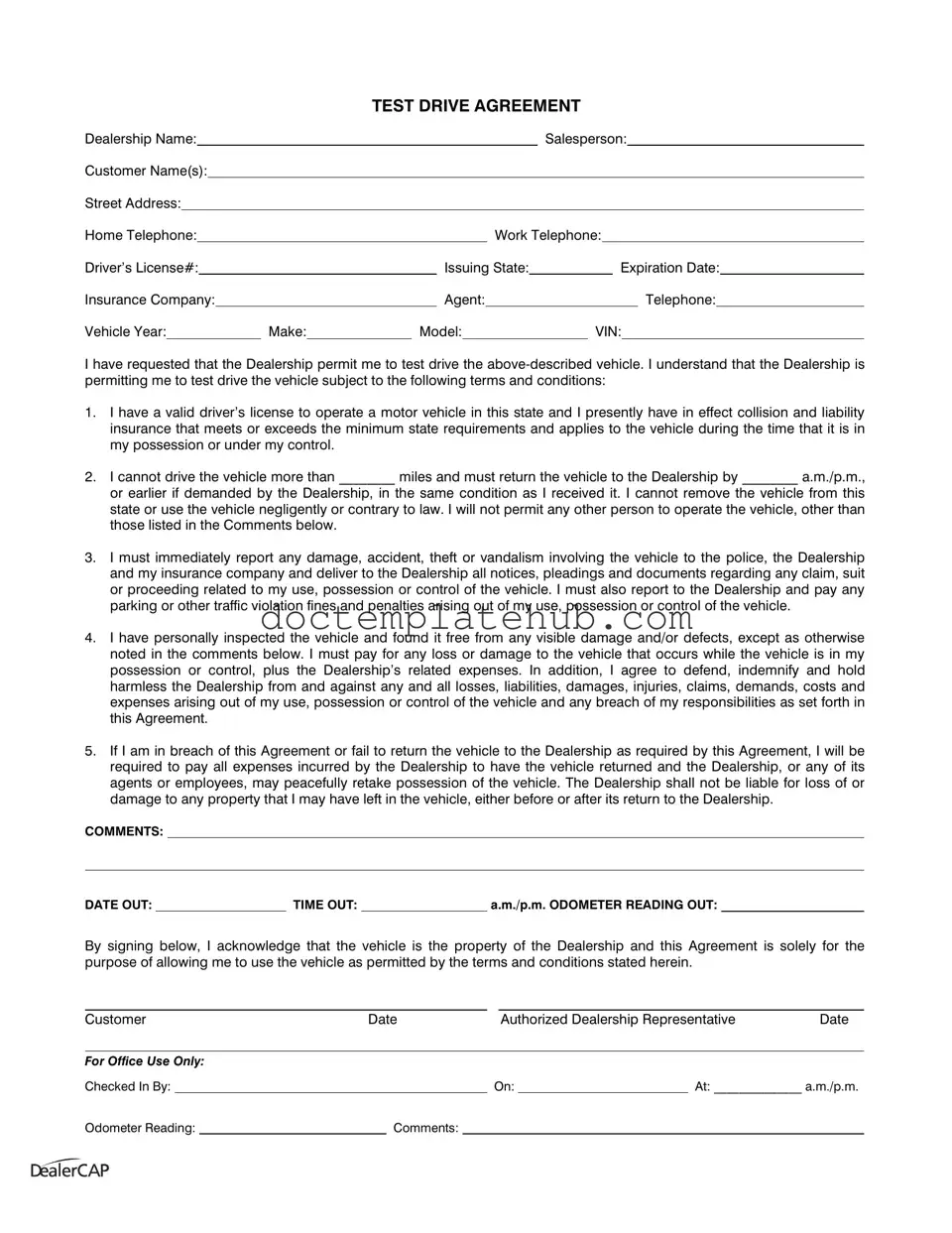The Rental Agreement is a document that outlines the terms under which a vehicle is rented from a dealership or rental company. Similar to the Test Drive Agreement, it requires the renter to provide personal information, including a valid driver’s license and insurance details. Both agreements emphasize the importance of returning the vehicle in the same condition it was received and outline the responsibilities of the renter in case of damage or accidents. The Rental Agreement typically includes specific mileage limits and timeframes for returning the vehicle, mirroring the conditions found in the Test Drive Agreement.
The Vehicle Purchase Agreement serves as a contract between a buyer and a dealership for the sale of a vehicle. Like the Test Drive Agreement, it contains essential buyer information and details about the vehicle being sold, such as make, model, and VIN. Both documents include terms that protect the dealership's interests, such as clauses about the condition of the vehicle and the buyer's responsibilities. While the Vehicle Purchase Agreement finalizes the sale, the Test Drive Agreement allows for a temporary use of the vehicle, highlighting the varying stages of vehicle transactions.
The Insurance Waiver is a document that may be required when renting or borrowing a vehicle. It often parallels the Test Drive Agreement in that it outlines the responsibilities of the driver regarding insurance coverage. Both documents emphasize the need for valid insurance and detail what happens in the event of an accident or damage. The Insurance Waiver often requires the driver to acknowledge that they are responsible for any costs not covered by insurance, similar to the indemnification clauses found in the Test Drive Agreement.
The Liability Release Form is commonly used in various activities where participants engage in potentially risky behavior. This document, like the Test Drive Agreement, requires individuals to acknowledge the risks involved and release the provider from liability in case of injury or damage. Both forms aim to protect the entity providing the vehicle or service while ensuring that the individual understands their responsibilities. The focus on personal accountability is a common thread that runs through both documents.
The Consent to Use Vehicle Form is often utilized by organizations or individuals allowing someone else to use their vehicle. This form shares similarities with the Test Drive Agreement, as it requires the user to provide personal information and acknowledges their responsibility for the vehicle's care. Both documents emphasize the need for valid driver’s licenses and insurance, ensuring that the vehicle owner is protected while allowing another person to operate their vehicle.
The Loan Agreement is a financial document that outlines the terms under which one party borrows money from another. While it may seem different at first glance, it shares commonalities with the Test Drive Agreement in terms of outlining responsibilities and conditions. Both agreements require clear communication of terms, including what happens if the borrower fails to meet their obligations. Each document serves to protect the interests of the lending party while ensuring that the borrower understands their responsibilities.
The Service Agreement is often used when a service provider and a client agree on the terms of a service to be rendered. Similar to the Test Drive Agreement, it lays out the expectations and responsibilities of both parties. Both documents highlight the importance of adhering to specific terms and conditions, including timelines and quality of service. The focus on mutual agreement and understanding is a key feature shared by both agreements.
For those looking to create a Durable Power of Attorney in New York, it's essential to understand that this legal document ensures your chosen representative can make decisions for you if you become incapacitated. To explore comprehensive resources and templates for this process, you can visit smarttemplates.net, which offers valuable guides on how to properly complete and manage this important legal form.
The Maintenance Release Form is a document that allows a vehicle owner to authorize maintenance work on their vehicle. Like the Test Drive Agreement, it includes details about the vehicle and requires the owner's acknowledgment of responsibility. Both forms emphasize the importance of maintaining the vehicle's condition and outline what happens if the vehicle is not returned in acceptable condition. The shared focus on care and responsibility connects these two documents.
The Indemnity Agreement is a legal document that protects one party from liability for actions taken by another party. This agreement bears similarities to the Test Drive Agreement in that both require individuals to accept responsibility for their actions and any resulting consequences. Both documents aim to protect the entity providing the vehicle or service, ensuring that users understand their obligations and the potential risks involved. The emphasis on accountability is a common theme that ties these agreements together.
